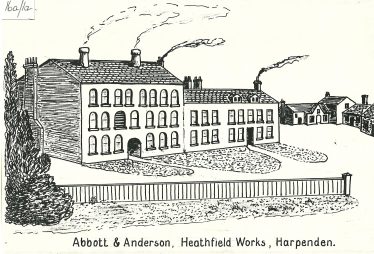
Pen drawing of Heathfield works, before it was destroyed by fire in 1916. Credit: LHS archives, BF 16.1
Harpenden Fire Station stands on the site of an industrial site on the west side of Leyton Road, behind the Silver Cup, known as Heathfield Works. An early C19 engraving shows the building when it was the residence of Thomas Reynolds. From 1805 to 1856 it was let to James Wyatt, a barrister.
A number of enterprises have been associated with Heathfield Works:
- Field’s Hat Factory was here from the 1870s until it moved to Grove Road (Southdown) in 1883, and then to Kingcroft Road in 1927.
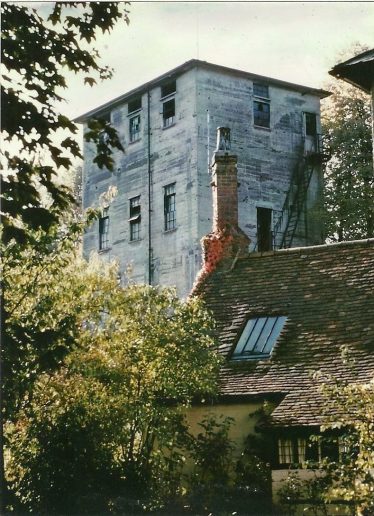
Abbott’s factory, c.1960. Credit: LHS archives, Jim Jarvis Collection (donated 2013)
- Abbott, Anderson & Abbott Ltd, manufacturers of oilskins since 1867 who moved here in 1883.
(see also http://www.gracesguide.co.uk/Anderson,_Abbott_and_Anderson for some further information.) A disastrous fire destroyed the factory full of very flammable material on 21 February 1916. They moved to temporary accommodation in Southdown, until the premises were rebuilt, and continued there until 1964, when the firm was acquired by Edward MacBean and Co. of Glasgow and all production work was transferred to Scotland.
- The Cooper Printing Equipment Co. Ltd., Heathfield Works, Leyton Road, who produced flexographic printing presses, sheet-fed flexo and ancillary equipment, stereo manufacturing equipment and special purpose printing machines.
- Harpenden Garden Centre occupied the site after the demolition of the Abbott & Anderson factory in the 1990s, until the fire-station was built. The Garden Centre moved to Amenbury Lane, until the Village Surgery was built on that site in c.2004, after moving from 15 Leyton Road.
Harpenden Fire Station moved from its premises alongside Park Hall in 1994. Coopers Mews, a gated housing development, was built in 2003.
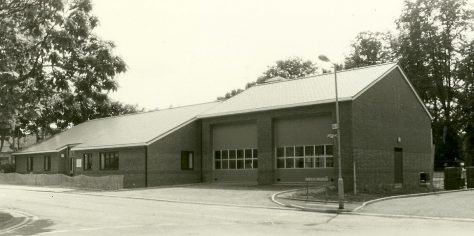
Harpenden Fire Station. Credit: LHS archives
There was a refreshment hut on the green next to the Silver Cup
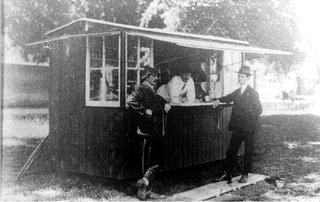
Credit: LHS archives – 7603
Some Abbott advertisements:
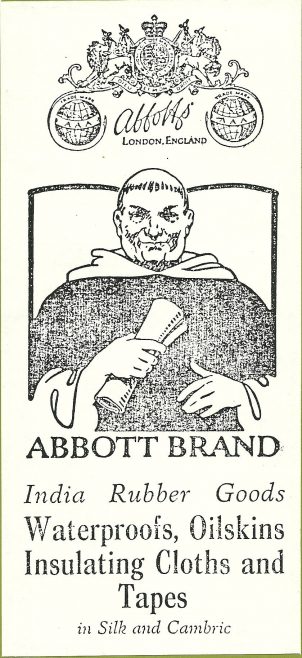
The Abbott brand. Credit: LHS archives BF16.1b

Label for use of oilskin. Credit: LHS archives BF 16.1c

Comments about this page
Growing up in Harpenden in the early 1960’s, the Abbotts factory impressed itself into my young mind on account of its gaunt and somewhat ‘spooky’ appearance. We passed it regularly on the way to Rothamsted Park or the swimming pool, and I knew it only as the “Hat Factory”. As a child one tends to take one’s surroundings for granted, so I assumed it must have always been there, and always would be.
One day years later as a teenager, I noticed it had gone and I was a little saddened that this feature from my childhood was no longer there. I had no knowledge of when it disappeared, and I wished I had paid more attention to it while it was there. It bothered me that I had not found out more about it and taken a photograph of it. I tried asking around, searching the library etc but could find nothing more about it.
I left Harpenden in 1975 and moved up north, eventually migrating to New Zealand. But the impression in my mind of this strange building never left me. When the internet appeared I tried searching for it there from time to time, and though I unearthed a treasure trove of other old Harpenden-images (like the famed Granary Lane water tower(s) which also lodged in my young mind), it was years before I finally came across the photo and history of this mystical building on this website. My thirst for this knowledge was assuaged. My disquiet at having missed the passing of this (to me) iconic landmark was eased. My mind is now at rest, Thank-you.
I worked at “Abbots” for 7 or 8 years and knew Basil very well. His main passion was his whippets and he had Ganex waterproof coats made for them in the Harold Wilson style complete with tartan linings.
I also knew Phil Read not just because of being at “Abbotts” together but my grandparents lived next door but one at 93-94 Southdown Road. I used to go to the Carters in Crabtree Lane to take their rent.
Another Southdown Road resident at Providence Place was Bill Yeadon, who also worked at “Abbotts”, part time. He was disabled and travelled in a chair with two levers to power it. When he got to the top of Bull Road he did not have the strength left to get over the then A6.The man from the coffee stall used to go over and give him a push.
Geoff Carter, now living in Spain, has been sending us memories of the cottages his grandparents owned, close to the railway bridge on Wheathampstead (then Southdown, now Walkers) Road – nos. 92-99, since demolished to make way for Walkers Court. Phil Read at 96, next door to the Carters, worked at Abbotts, and brought home offcuts of oilskins which Mrs Carter used to fire the copper in her outhouse for the weekly wash. Geoff comments that “the copper was also used to make dandelion wine which was quite potent.”
My great grandfather and his brother (Fred and Jack Abbott) were the original owners of the firm and my grandfather William Nelson Abbott was a part owner – they also had another factory at 39 High Town Road, Luton but I have absolutely no idea what happened to that except we lived in a flat next to the factory before moving to Churchfield, Harpenden in 1956/7. My father Basil Abbott was a director.
My first job on leaving school in 1956 was as “shipping clerk” with Abbotts, as it was known. The owner then was Mr Nelson Alfred Samler-Brown from Battlefield Road St. Albans. Another director was Mr Basil Abbott from Churchfield. In addition to oilskins they made varnished electrical insulating tape in black and yellow. During the summer this was seen on every allotment in Harpenden to frighten birds away. I was there until they closed.
Add a comment about this page